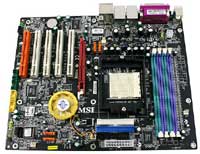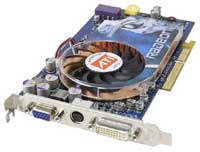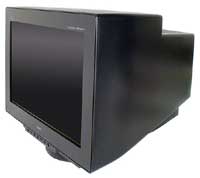High-End Gaming System
We've covered the Mid-Range and Budget sectors, so all that is left is the High-End. While there is a lot of competition in the other sectors, there really are not that many options on the bleeding edge. If money is no object - and it shouldn't be if you're thinking of spending a couple of months' rent on a game system - you can go out and buy the best parts that are available. That is in essence what we have in our High-End rig. However, we really don't recommend that anyone actually spend this much money on a gaming system. A better plan would be to pick out a few of the items that you think are the most worthwhile and stick with the Mid-Range configuration for the remainder of the system.
| High-End AMD Athlon 64 System |
| Hardware |
Recommended Component |
Price |
| Processor |
AMD Athlon 64 FX-55 1MB 2.6 GHz (939) |
877 |
| Motherboard |
MSI K8N Neo2 Platinum |
131 |
| Memory |
2x512MB Crucial Ballistix 2-2-2 1T |
262 |
| Video Card |
Sapphire X800 XT 256 MB GDDR3 AGP |
461 |
| Hard Drive |
Western Digital Raptor 74GB SATA 10000RPM 8MB Model WD740GD |
173 |
| Hard Drive |
Maxtor 300GB SATA 7200RPM 16MB Model 6B300S0 |
207 |
| Optical Drive |
NEC DVD+/-RW Drive Model 3500A |
72 |
| 2nd Optical Drive |
Lite-On 16X DVD-ROM Model SOHD-167T |
30 |
| Sound Card |
Creative Labs Audigy 2 ZS |
75 |
| Case |
Antec Lanboy Aluminum |
88 |
| Power Supply |
Antec True480 480W PSU with Blue LED |
95 |
| Display |
NEC/Mitsubishi FP2141SB-BK 22 |
634 |
| Speakers |
Logitech Z-680 5.1 THX Certified |
236 |
| Keyboard |
Logitech Internet Keyboard |
17 |
| Mouse |
Microsoft IntelliMouse Optical |
24 |
| Bottom Line |
|
3382 |

Click to enlarge. |
The choice of parts in some areas is not all that different from the Mid-Range configuration. Our motherboard recommendation remains with the MSI K8N Neo2 Platinum; even more so than the Mid-Range sector
If you are actually thinking about spending this much money on a computer, waiting for PCI Express motherboards with SLI support would really make sense. In that case, you could go with a 6800GT card now and upgrade your gaming performance with a second 6800GT when you need more performance. We expect the SLI-capable motherboards to begin appearing at retail within the next month. Until we actually see the parts on sale, we will not be listing them as an actual recommendation.
We also continue to go with the same NEC DVD burner as well as the keyboard and mouse. Some people really prefer wireless input devices, but for gaming, we personally continue to prefer wired variants. As before, go with what you're most comfortable using. The other components are all upgraded, but we are reaching the point of diminishing returns. The total system cost is roughly twice that of the Mid-Range system, and yet performance is, at best, maybe 25% faster. Let's look at the specifics.
We start with what is the fastest current processor, the AMD Athlon FX-55. Running at 2.6 GHz and with strained silicon, our initial results have shown it to be faster than any other CPU in games, and those looking for even more performance can try their hand at overclocking it. For the RAM, we have upgraded to some high quality, low latency Crucial Ballistix. With 2-2-2 timings at 200 MHz and low timings all the way up to its maximum clock speed of around 270 MHz, the Crucial RAM performs very well. Any memory that uses the latest Samsung TCCD chips is also worth consideration, and it can usually reach even higher clock speeds. OCZ PC3200 Platinum Rev. 2 is one such example, and we use the Samsung TCCD DIMMs as our standard RAM for testing. If you don't plan on overclocking, however, there's really little to differentiate one set of 2-2-2 timing RAM from another.

Click to enlarge. |
For the graphics card, we have selected ATI's X800 XT chip. The X800 XT Platinum Edition and 6800 Ultra are also possibilities for those who simply must have the best. The X800 XT strikes a nice balance between price and performance, as it outperforms the 6800GT in most games that don't have Doom 3 in the title and it costs $75 less than the slightly faster chips. Sapphire wins this category as the least expensive X800 XT card. For hardcore Doom 3 players, the NVIDIA cards remain the better choice, and if you're interested in SLI, there are two important things to remember. First, of course, is that you need to wait for PCI Express motherboards to become available, which may be a month or two out - we're sure that NVIDIA's partners are trying desperately to get the boards to market before Christmas. The other critical factor is that you will need to "downgrade" to a 6800GT. As the 6800 Ultra is a two-slot design, there will not be room to put two 6800 Ultras in a system - at least, not on the boards that we've seen. Two 6800GT cards are significantly faster than a single 6800 Ultra, though, so the tradeoff is worth it in our book.
Our hard drive selection may be overkill, but we have paired the fastest SATA hard drive available - the Western Digital Raptor - with a fast, but spacious, Maxtor DiamondMax 10 (a.k.a. Maxline-III) drive. The Maxtor drives are so new that we really don't have much data in terms of reliability, so if you have any personal experience with the drives, we'd like to hear from you. On the optical side of things, we have added a standard DVD-ROM drive to the burner, allowing for DVD to DVD copying - or CD to CD copying - if you need it. The speakers are Logitech's Z-680 5.1, which provide great sound at a reasonably affordable price. They compare favorably with Klipsch ProMedia Ultra 5.1 speakers and cost significantly less. We have also thrown in a sound card for good measure - the Creative Audigy 2 ZS is designed with gaming in mind and provides better quality than most integrated solutions as well as slightly better performance.

Click to enlarge. |
Finally, we wrap things up with the case and monitor selections. For the case, we have selected the Antec Super Lanboy paired with an Antec True480 power supply. It is very similar to the SLK3700-BQE in design, but uses an aluminum body instead of steel and has a case window on the side. Two 120 mm fans are included, and it also comes with a carrying harness that can come in handy if you're the type to haul your computer to LAN parties. Lian Li and Silverstone also make some very nice cases if you're willing to spend more money. The majority of high-end cases lack a power supply, so we used an Antec True480 480W PSU. The Antec NeoPower 480 and Ultra X Connect are also alternatives worth considering - they are 480W and 500W respectively, and they have detachable power rails so that you can avoid cluttering up the insides of your case with unused cables.

Click to enlarge. |
Our choice of display is a large 22" (20.0" viewable) NEC monitor. Providing high refresh rates (85 Hz) at even 2048x1536 as well as the ability to run at other resolutions without interpolation - the Achilles heel of LCDs - we still prefer a large CRT to LCDs for games. It also comes with four USB ports, if that sort of thing interests you. There are other 22" NEC CRTs that cost less, but if you want a huge monitor for gaming, you'll want one that supports 2048x1536, as few games support the less common resolutions such as 1920x1440. The drawback for such a CRT is that it is large and heavy, making it less than ideal for transportation to LAN parties.

Click to enlarge. |
If portability is your style, we recommend a good quality 19" LCD instead. Unlike CRTs, an LCD's viewable area is the same as their screen size, so a 19" LCD is really only slightly smaller than a 21/22" CRT (which both have a 20.0" viewable area). Low response times are the most important aspect of LCDs that will be used in gaming, and for this, we recommend the ViewSonic VP912B 19" LCD. With a 12 ms response time, there is virtually no ghosting. It does cost more, but it works great. The native resolution is 1280x1024, but we have not yet encountered any 19" LCDs that support 1600x1200 with a 12 ms response time. Besides, 1280x1024 is not quite as demanding of the GPU as 1600x1200 - if your LCD runs at a native 1600x1200 resolution, you'll need to either lower the resolution when game complexity increases or else, you'll need to upgrade your GPU more often. Neither one is very appealing. Remember also that you want a DVI-D connection on any LCD; otherwise, you're still stuck with an analog signal that can affect image quality, particularly at high resolutions.















70 Comments
View All Comments
spartacvs - Wednesday, January 5, 2005 - link
I decided to wait and I'll most probably go for nforce4. One thing I reallly like about your guide is the fact that there is many budgets. Most of the guides provides 3 systems (budget, price/performance and power) but more systems is really helpfull.Careless Joe - Tuesday, January 4, 2005 - link
RE: the "Cheap" psu in the budget case. Its a re-badged fortron. Very reliable.JarredWalton - Saturday, December 4, 2004 - link
Just FYI, I recently upgraded from the integrated audio on my MSI K8N Neo Platinum to an Audigy 2 ZS. My benchmarks in Half-Life 2 (using a measley 9800 Pro) went up a whopping 1 FPS. It might matter more with a faster GPU, but for my setup the sound card didn't matter much. It did, however, eliminate some static/noise from the audio. I couldn't hear it on the speakers, but on headphones it was very noticeable.Was it worth $75? That depends on how much disposable income you have and how annoying any extra static is. Since I often use headphones on my PC at night (no need to wake the wife and neighbors), it was annoying enough for me that I went and spent the money. For most people - particularly those using moderate to cheap speakers - you probably wouldn't notice.
SDA - Saturday, December 4, 2004 - link
Jarred, very true.. I've seen people defend PowerStream purchases after being told that they're the same as Tagans (which I don't do, by the way; I hate to even implicitly insult something that someone else owns) by saying that OCZ is a good name and is better-recognized, as if that really has anything to do with PSU performance. If you ask me, I don't think that sort of thing should really be factored into recommendations.. if someone wants to pay more for a brand name (when it has been demonstrated that there's no functional advantage), they're probably in the minority. (If someone wants to pay more for the PowerStream's looks, they need 20ccs of taste, stat. .. kidding, PowerStream owners ;)Oh, and spartacvs, just remember that integrated audio (non-SoundStorm integrated audio, anyway) will eat more CPU than a dedicated sound card will. It's not much of a big deal with today's overpowered PCs, if you ask me, and you still get plenty of bang for your buck (infinite bang for your buck, actually, since integrated audio is free).
spartacvs - Friday, December 3, 2004 - link
JarredWalton, yes, I think I understand your argument: AGPat the end of his life and PCIe is comming in.I had bad information about integrated audio. Integrated audio is not fantastic but I'm sure it'll be a majhor improvment over my old sb live!value 4.1... And, as I said, it's a way to save a few dollars. Something I, unfortunately, have to be very cautious these days :(
Thank you very much for your wise comments.
JarredWalton - Friday, December 3, 2004 - link
SDA - I understand that the internals are the same. For some people, however, the outside (and the brand) will matter. It doesn't bother me much, but convincing others of this is more difficult to do. I always prefer the weight test for PSUs (assuming you're at a store where you can pick up the PSU). All things being apparently equal, always go with the heavier PSU. :)Spartacvs - *all* motherboards include integrated audio these days. What Nforce4 doesn't include is the SoundStorm audio that was in Nforce1 and Nforce2 (certain models). NVIDIA is supposed to be working on a high-definition audio solution, but when that will actually arrive is a little difficult to say. The audio that will be on Nforce4 is the same as what is on most Nforce3 boards these days, so don't worry too much about that. If audio is really important to you, pick up a Creative Audigy 2 ZS (for games) or the M-Audio Revolution 7.1 (for more serious audio work).
SDA - Friday, December 3, 2004 - link
That depends on your definition of close, Jarred ;) The only real differences between them are cosmetic (shell, sticker, brand). The components, layout, and design are nearly identical.If you're having trouble with this concept, here's a parallel for you: Alienware's older notebooks (before they switched to Uniwill) and equivalent Sager notebooks (with a comparable configuration, obviously). Same platform, same layouts, same chassis, same components (possible that they used different brands of memory or something, but that's about it), same party assembling them; the differences are almost entirely cosmetic, and the ones that aren't don't apply to functionality.
Hopefully this is all a little clearer now, the world of computer hardware is really far too convoluted for its own good..
spartacvs - Thursday, December 2, 2004 - link
Ok, thanks for you answer. The place I want to buy have most of the memory brands. It's just muskin, they have only a few models.As for the MB. What I don't like about nforce4 is the lack of integrated audio. It increase the price tag a little bit more and I'm tight on money :(
JarredWalton - Thursday, December 2, 2004 - link
SDA - Just pointing out that they're not identical. Close, perhaps, and which you like more is probably more a matter of preference, but they certainly aren't identical.Spartcvs - Corsair, GEIL, Kingston, OCZ, and quite a few others are decent RAM. For value RAM, Kingston and Corsair are probably the most widely spread, but I don't really know what other countries are like in terms of availability. The difference between the motherboards is more difficult to quantify. I really like Abit boards, but I'm not as keen on the VIA chipset - NVIDIA just seems more stable in my experience. Either one is still a fine motherboard, and there are several other socket 939 NForce3 250 boards available. Now, though, waiting for NForce4 non-SLI might be a good idea - get one of those for ~$130 and get a 6600GT PCIe card.
spartacvs - Thursday, December 2, 2004 - link
Hey guys, I have a few questions.Fisrt, I do not overclock my system and will most probaly go with the Antec 2650 case because it's smaller and still a good case. Will also take the 120 GB HD because 160 is overkill for me (hey I hardly fullfill my actual 40 GB).
I hesitate between the abit board and the msi one. What do I lose going for the abit rather than the msi? The Abit is a via chipset, right?
Where I want to buy they don't have much of the mushkin memory. Can you recommand another brand (and model please because there is so many type of memory modules, it's easy to be lost).
Thanks